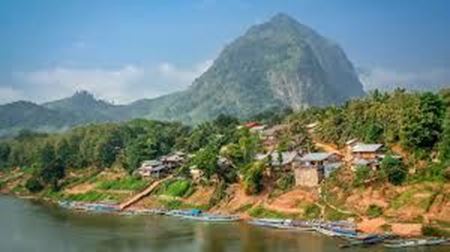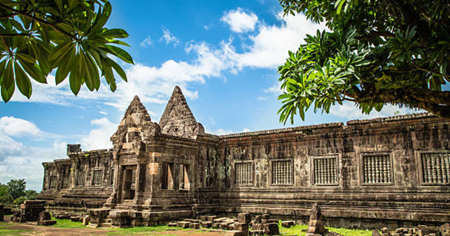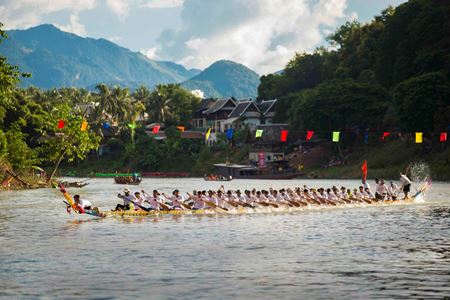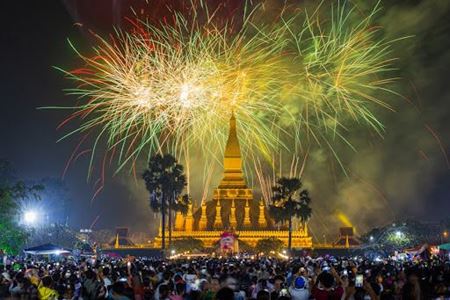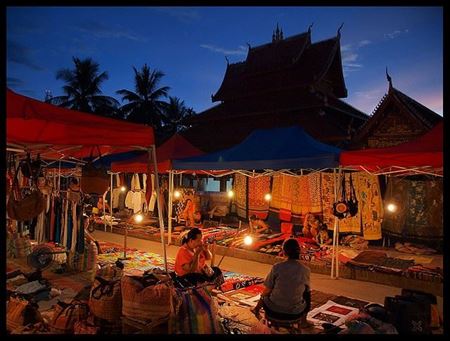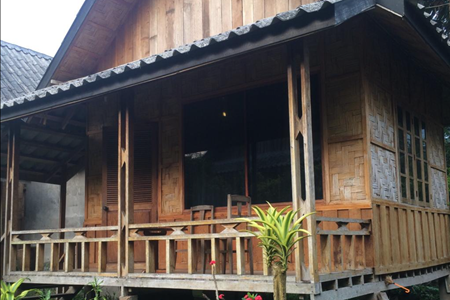THAT LUANG FESTIVAL IN VIENTIANE - THINGS TO DO & CULTURAL HIGHLIGHT
1. What is Pha That Luang?
Pha That Luang, also known as the Great Stupa, was built in 1566 by King Setthathirath after moving the capital from Luang Prabang to Vientiane. It is regarded as the most sacred monument in Laos, believed to enshrine a relic of the Buddha. Covered in gold, the stupa is not only a religious site but also a national symbol, representing Lao culture, identity, and devotion to Theravāda Buddhism.
2. What is That Luang Festival?
That Luang Festival, locally known as Boun That Luang, is the largest and most significant religious celebration in Vientiane. It takes place annually during the full moon of the 12th lunar month, typically in November. The festival lasts from three to seven days and draws thousands of Buddhist devotees from across the country who come to pay homage at Pha That Luang. Beyond its religious aspects, the festival is also an important cultural occasion filled with traditional rituals, performances, and community gatherings.
3. Festive Activities
3.1. Wax Castle Procession
The Wax Castle Procession marks the beginning of the That Luang Festival and usually takes place one to two days before the main ceremony. In Lao, the ritual is called “Phasat Pheung”, referring to ornate miniature castles made of beeswax. These handcrafted models, often ranging from 1 to 3 meters in height, are built by temples, schools, villages, or local organizations using bamboo or wooden frames. They are decorated with gold-colored wax, flowers, candles, paper ornaments, and symbolic items — typically designed to resemble the Pha That Luang itself.
The procession begins at Wat Si Muang, an important spiritual center in Vientiane. From there, groups parade along designated city routes toward Pha That Luang. Along the way, participants carry candles, incense, and flowers, beat traditional drums and cymbals, and chant or sing Buddhist verses. Some groups also wear traditional ethnic costumes, creating a lively yet respectful procession.
Upon arriving at Pha That Luang, participants circle the stupa three times in a clockwise direction, led by monks from Wat That Luang who chant sacred texts. The wax castles are then placed around the stupa as symbolic offerings. This ritual reflects the community’s reverence for Buddhism and their intention to accumulate merit through collective effort. For visitors, it offers a clear glimpse into Lao cultural expression, blending craftsmanship, ritual, and community pride in a deeply symbolic way.
3.2. Almsgiving Procession (Tak Bat)
The morning following the wax procession — usually the final day of the festival — begins with the Tak Bat ceremony, a mass almsgiving ritual. By 5:00 a.m., thousands of devotees have already gathered in and around the Pha That Luang grounds to prepare their offerings. The ceremony officially begins at 7:00 a.m., with the arrival of hundreds of monks from across Laos.
During the ritual, people sit silently along the walkways, holding offerings of sticky rice, fruit, flowers, or small donations. Monks pass by in lines to receive alms into their bowls. This practice is seen as a way for laypeople to accumulate merit and express their devotion.
A traditional element during this ritual is the pouring of water onto the ground, a symbolic act of transferring merit to deceased loved ones, often invoking the spirit of Ngamae Thorani — the Earth Goddess. Some also release caged birds as an act of compassion and spiritual purification.
After the main almsgiving, people queue to enter the inner grounds of the stupa to light incense, place offerings, and pray for blessings. The mood is quiet and reflective, and although the scale is large, the event maintains an atmosphere of calm and reverence.
3.3. Lao Hockey Game (Ti Khee / Tikhy)
In the afternoon, a traditional Lao sport called Ti Khee (sometimes spelled “Tikhy”) is held near the stupa grounds. The game resembles field hockey, played with curved sticks and a ball. Originally part of a ceremonial rite, it has evolved into a fun cultural event often involving local community teams or government staff. The match is informal but draws a large audience, blending tradition with entertainment.
3.4. Firework Displays
The festival concludes under the full moon with a final candlelight procession. Devotees gather once again at Pha That Luang, carrying candles, flowers, and incense. In recent years, the closing night often includes a firework display — not as a commercial show, but as a symbolic closure to the multi-day celebration, illuminating the golden stupa and marking the end of Laos’ most sacred festival.
3.5. Trade Fair with Local Crafts and Food
A festival market surrounds the stupa throughout the event, offering local handicrafts, religious items, and a wide range of traditional food. Visitors can try dishes like Khao Poun (rice noodle soup) or Tom Kai (Laotian chicken soup), often served after the main ceremonies. The market creates a friendly space for both devotees and tourists to explore the culinary and artisan heritage of Laos.
3.6. Traditional Lao Music and Dance Performances
Evenings during the festival are filled with cultural performances. Music and dance troupes perform “Lao classical and folk arts”, dressed in elaborate traditional costumes. These performances are staged in public areas near the stupa and highlight the diversity of Lao cultural expression through live music, singing, and Lamvong dance.
4. When Is That Luang Festival in 2025, 2026, 2027, 2028
That Luang is the most important religious and cultural festival in Laos, attracting thousands of monks, local worshippers, and travelers from around the country and abroad. It’s a unique opportunity to witness Lao traditions at their most vibrant — from spiritual rituals to cultural performances.
The festival follows the Lao lunar calendar, so the date will change every year. If you want to plan your trip to Laos to coincide with this special event, it’s worth checking the dates early and preparing in advance.
Here are reference dates for upcoming years to help you get started:
| Year | Estimated Festival Day |
| 2025 | Wednesday, November 5 |
| 2026 | Tuesday, November 24 |
| 2027 | Saturday, November 13 |
| 2028 | Wednesday, November 22 |
Most visitors arrive a few days before the main ceremony to experience highlights like the Wax Castle Procession, traditional games, and evening performances. The final day, marked by the grand almsgiving and candlelight rituals, is held on the full moon.
Travel tip: Consider arriving in Vientiane 2–3 days before the full moon, and book your stay early, as accommodations near Pha That Luang tend to fill up quickly during this time.

